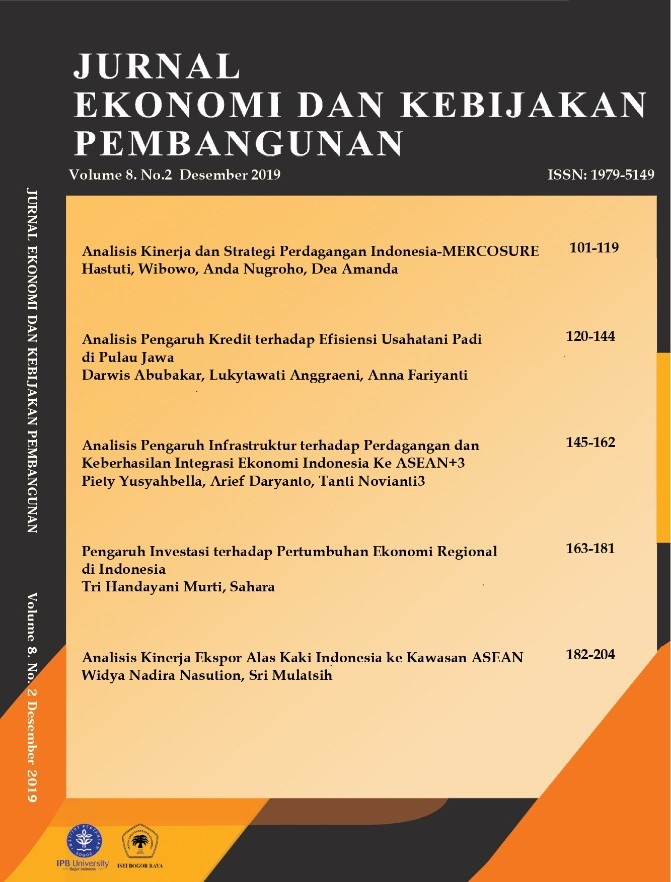Analysis of the Effect of Infrastructure on Trade and the Success of Indonesia's Economic Integration into ASEAN+3 IPB University
Abstract
Export and import from Indonesia to ASEAN+3 countries reached 52.3% and 62.37% of the total trade of Indonesia to the world. Infrastructure played a vital role in supporting successful trade. During the period 2007-2017, loading and discharging flows of Indonesian goods were dominated by sea transportations modes by 96%. Indonesia's infrastructure is far lower than other ASEAN+3 countries especially marine infrastructure and the internet users. The purpose of this study is to describe Indonesia's trade with ASEAN+3 countries, to the determinant that influence Indonesia’s trade into the ASEAN+3 and to analyze the success ratio of Indonesia to ASEAN+3. This study is using descriptive analysis, gravity model and success ratio method. This study is using descriptive analysis, gravity model and success ratio method. The variables used in this study are the gross domestic product per capita, economic distance, air transport freight, container port traffic, internet user and mobile phone. The results show that Indonesia's highest export - import is with China. ATF has no significant effect on both export and import, while other variables give a significant positive effect except GDP per capita that has a significant negative effect to export. The success of economic integration for Indonesia's exports and imports into the ASEAN+3 region has not been fully achieved.
References
[APJII] Asosiasi Penyelenggara Jasa Internet Indonesia. Laporan Survei Penetrasi dan Profil Perilaku Pengguna Internet Indonesia Tahun 2018 [internet]. [diunduh 27 Oktober 2019]. Tersedia pada: https://www.apjii.or.id/
[BAPPENAS] Badan Perencanaan Pembangunan Nasional. Kajian evaluasi pembangunan bidang transportasi di Indonesia. Jakarta (ID): BAPPENAS.
[BPS] Badan Pusat Statistik. Bongkar Muat Barang Antar Pulau dan Luar Negeri di Pelabuhan Indonesia [internet]. [diunduh 2019 Februari 3]. Tersedia pada: https://www.bps.go.id/
Daryanto A, Sahara. 2016. The impact of logistic performance on the Indonesia agricultural export. Journal of ISSAAS. 22(2):28-39.
Dundovic, Cedomir dan Hess, Svjetlana. 2005. Exploitability of the port container terminal stacking area capacity in the circumstances of increased turnover. ISEP 2005.
Fejzic A, Covrk E. 2016. Infrastructure, transport costs, and Bosnia and Herzegovina’s trade: a gravity model approach. Ekonomskki Vjesnik Paper. 77-90
Ismail NW, Mahyideen JM. 2015. The impact of infrastructure on trade and economic growth in selected economies in Asia. ADBI Working Paper Series No.553.
Kawai M, Naknoi K. 2015. Investment: ASEAN economic integration through trade and foreign direct investment: long-term challenges. ADBI Working Paper.
[Kemenperin RI] Kementerian Perindustrian Republik Indonesia. Dukung Penggunaan Produk Dalam Negeri. [diunduh 2019 April 22]. Tersedia pada: https://www.kemenperin.go.id
[KPPIP] Komite Percepatan Penyediaan Infrastruktur Prioritas. Proyek Prioritas. [diunduh 2019 Juni 11]. Tersedia pada: https://www.kppip.go.id
[KSP RI] Kantor Staf Presiden Republik Indonesia. Laporan 5 Tahun Bidang Ekonomi. [diunduh 2019 Juni 12]. Tersedia pada: http://presidenri.go.id
Nordas HK, Piermartini R. 2004. Infrastructure and trade. Economic Research and Statistics Division WTO.
Orzan B. 2017. Information and communications technology (ICT) and international trade: evidence from Turkey. Eurosian Economic Review. 8(1): 93-113.
Ridwan. 2011. Analisis Aliran Perdagangan dan Investasi dalam Integrasi Ekonomi ASEAN: Pendekatan Gravity Model [Tesis]. Bogor (ID): Institut Pertanian Bogor.
Salvatore D. 2013. International Economics. Eleventh Edition. New Jersey (US): John Wiley & Sons, Inc.
Stepherd B, Wilson J. 2008. Trade Facilitation in ASEAN Member Countries: Measuring Progrees and Assesing Priorities. Policy Research Working Paper. 20(4):367-383.
[UNCOMTRADE] United Nations Conference on Trade and Development. Data GDP 2007-2017 [internet]. [diunduh 2019 Januari 5]. Tersedia pada: https://comtrade.un.org/data/
Verico K. (2015). Indonesia in the ASEAN economic integration framework. Munich Personal RePec Archive.
[WB] World Bank. 2008. A Handbook of International Trade In Services. Oxford University Press.
[WB] World Bank. Data GDP dan Perdagangan Negara ASEAN+3 [Internet]. [diunduh 2019 Februari 27]. Tersedia pada: http://data.worldbank.org/indicator
[WEF] World Economic Forum. 2014-2018. The Global Competitiveness Report 2014-2018 [Internet]. [diunduh 2019 Januari 12]. Tersedia pada: http://www3.weforum.org
Wilson W, Blonigen BA. 2006. New measures of port efficiency using international trade data. NBER Working Paper No 12052.
Yushkova. 2013. Impact of ICT on trade in different technology groups: Analysis and implications. International Economics dan Economic Policy.
Authors

This work is licensed under a Creative Commons Attribution-NonCommercial-ShareAlike 4.0 International License.
The authors who publis article(s) in Jurnal Ekonomi and Kebijakan Pembangunan have to understand and agree that the copyright of article published is owned by Jurnal ekonomi and Kebijakan pembangunan including to reproduce, distribute and sell this journal to public.

